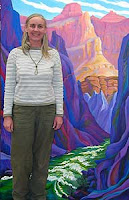The other day a customer came ambling into the store and, referring to Buffy the Wonder Dog, who, for maximum attention, generally resides on the mat just outside the Kokopelli doors, asked, “Who’s dog is that?” “She belongs to me, although she thinks I belong to her,” I replied. “Good, very commendable,” the woman said, “You know it’s an honest establishment when there is a dog involved.”

Lalana with Navajo Folk Art
As Priscilla, my trusty sidekick, moved about the store, straightening Navajo rugs and baskets; polishing turquoise bracelets, buckles and bolos; and dusting folk art carvings, Barry pecked out his latest Tied to the Post story in his nearby office. Surveying the scene, I counted myself among the fortunate few. Surely I am extremely lucky to have so many enjoyable people to work with.
Almost three years ago, Tina, our internet manager, announced she was pregnant. “What will we do now?” Barry and I wondered aloud. Tina had become an indispensable part of our organization, and we worried we might lose her once the baby arrived.
Like Dacia, Kira and Grange before her, however, when Lalana arrived she was simply incorporated into the overall trading post package. Now, having been raised in the store since birth, she totters about like it is her own private domain; and of course it is. As Lalana follows Priscilla to the cafe for a cup of coffee, stopping to pat Buffy on the way, we watch in delight, wondering how we ever got along without her and question what we will do when she grows up and leaves. She has become our latest trading post baby, an indispensable part of our identity.
As the day wore on, the sun began to sink in the west and a soft golden light filtered in through the windows, illuminating everything in honey-colored hues. The turquoise in the cases literally glowed. Barry, having finished his writing for the day, had become drowsy and decided to sit on the porch to enjoy the last warmth of autumn. Priscilla and I chuckled as his head bobbed up and down in a continuous cycle.
The incident reminded me of the early days of the trading post. Duke, who was approximately the same age Barry is now, would arrive at the store every day and he, Priscilla and I would manage what little business we had. Dacia was often reclining on the counter in a baby bassinet or strapped to my chest in an infant carrier.
Having gone to the Phoenix flea market to secure an abundance of Southwest patterned futons, Duke insisted I carry the prized merchandise out to the porch every morning and retrieve it every night. In the afternoons Duke would wander off and, although I began to wonder where he was going, I did not pursue him. One day an alarmed customer came into the store and announced, “There’s someone lying on your futons!” When we went outside to investigate, it was Duke, sleeping peacefully.

Barry & Buffy asleep on Twin Rocks Porch
With history repeating itself, Rose sneaked out the back door to capture Barry snoozing as the shadows crept ever closer. Unfortunately Barry roused himself one last time and spotted her lens peeking out from around the corner.
The warmth of autumn is gone, the chill of winter is upon us and Santa is preparing for his annual trip. In this season of giving, I have developed a feeling of complete satisfaction. What more can one ask than to be surrounded by so many happy, healthy individuals. In many ways, I feel that is what most accurately identifies both me and Twin Rocks Trading Post. Such is the family of this man.
Merry Christmas, and may the New Year bring you all the warmth and happiness of a late fall day in our beautiful red rock sanctuary.
With Warm Regards,
Steve, Barry and the Team.
Copyright 2008 Twin Rocks Trading Post.































